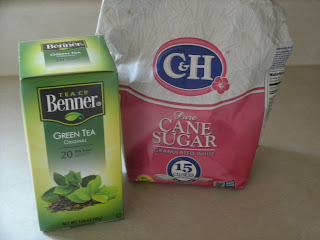Botswana
Botswana
Botswana is a small, landlocked country just north of South Africa. That's how I remember my college classmate Toomie describing it. Nobody knew where the country she was from was. Toomie was fun. We went on a class trip to a trade show in Orlando during the summer between our junior and senior year. I don't remember how many people were on the trip, but Toomie and I went to Epcot together on our free day. It was so funny, because the workers who were from various parts of Africa all immediately struck up a conversation with Toomie, but they kept giving me strange looks trying to figure out why this white lady was hanging out with a woman from Botswana. Toomie would notice and introduce me, and added that I had been to Africa - Kenya, and then I was welcomed warmly. They all seemed a bit amazed that a white American had been somewhere in Africa.
All I know about tea in Botswana comes from Alexander McCall-Smith, and his series of books from "The Number One Ladies' Detective Agency". I've never watched the show, but I've read the books. He talks about people drinking red bush tea (rooibos), or "regular" tea (meaning black tea). I found an article where he was interviewed about his love of tea, and he talked about the measures he goes to to get a good cup of tea while traveling. Not only does he bring his own tea, he has his own electric tea pot to brew it in - especially when travelling in the US. I have to agree that it is appalling to think of making tea with a coffee maker. The taste of coffee permeates the maker, and all hot water that comes out of it (much like the Keuring at work - I will gladly wait on a microwave before drinking the nasty water that comes out of those things).
In that interview, he talked about his childhood in Botswana, and how he drank black tea with tons of sugar in it. It wasn't until he was older that he realized that he was ruining the flavor with sugar, and started drinking it plain. I don't know what type of tea he carries with him on trips, but I know what my favorite black tea is. I also finally found a place to buy it. Our tea comes from a country a little further north. According to the world atlas, it's the 3rd largest tea producer. Kenya.
I learned to drink Kenyan tea black, even though that's not how most of the locals drank it. I figured that it would be perfect for this post. While I bought a box of Kericho Gold tea on Amazon years ago, I found it to be old, and low grade. Thankfully, there is an upscale tea shop (Gong Fu Tea) that is less than 2 hours drive from my home. They also do mail order. I don't intend to do advertising or brand placement on my blog, but this is truly the best source I've found for specialty tea items, and I'm sure there will be more field trips in the future.
So what is Kenyan tea? It's normally black tea (although some small farms are experimenting with making green and oolong teas as well now). It is make with the cut tear curl method that makes for small particles giving maximum color and flavor. Some tea heads consider this to be a low quality process, but that's how it's made as far as I'm concerned. Commercial tea blenders use Kenyan tea for color and strength in their teas.
To get started, I boiled some water, and placed some hot water in my steeping cup to warm it.
Stylish, I know. Actually, it works pretty well because I can measure my water while brewing. While my cover doesn't have the best seal (thanks to the spout), it works.
After this, I swirled my tea leaves with a little hot water to open them up (like I did with the gunpowder green in Morocco).
 |
| Look at that beautiful tea! |
The first time I brewed the tea according to instructions, it seemed weaker than what I remembered (I was drinking it straight when it was brewed at a strength to be combined with milk and sugar). I used 2 teaspoons (3 grams) with 6 ounces (3/4 cup or a scant 200 ml) of water. I brewed for 5 minutes, and came up with a tea that was a bit on the strong side (I added a little hot water to it). I brewed a second cup on the same leaves for 4 minutes and it came out perfect. I think I would start by brewing the first cup 3 minutes, and brew progressive cups stronger.
Okay, so it's not one of those elegant glass brewing vessels, but you can still see the tea leaves, and the developing color.
Almost there!
Ah. This is another moment when I wish I had the foodie vocabulary to describe the flavor. I can taste a little bit of Kenya in Lipton tea. This is the flavor, and the smell I remember. This is crisp mornings when there is a little chill in the mountain air. The Kenyan students bundled up in winter coats while the American students are walking around in shirt sleeves saying that it was a little bit chilly, but would warm up. The other students looked at us like we were nuts. In reality, we had survived yet another Midwestern winter, so temperatures that were probably in the 50s Fahrenheit (just over 10 Celsius) were warm enough for us.







Nothing can bring back the past quite like a taste or smell from it.
ReplyDeleteSo true.
Delete